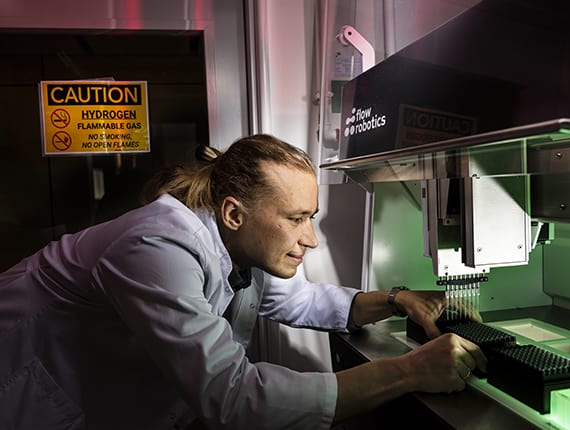University of Copenhagen
Up to 15 NGS projects at The University of Copenhagen, Department of Food Science, use flowbot® ONE to perform DNA purification.
At the Department of Food Science at the University of Copenhagen, a large number of projects featuring DNA sequencing are in the works.
Many of the projects use the pipetting robot, flowbot® ONE, to purify the DNA – one of the steps in the NGS pipeline. This has become instrumental for keeping up with the heavy workload.
Investigating the health of mother’s milk
We met up with PhD student Rasmus Riemer Jakobsen who uses the flowbot® ONE in his PhD project. The project sequences the microbes in mother’s milk and in the guts of infants and mothers to understand how they correlate to create a healthy childhood.
Before sequencing the DNA to carry out the analysis, the samples must be purified and prepared on 96 well plates. The DNA samples go through 12 different steps before they are completely clean and ready for sequencing, including washing steps and bead-based clean-up.
This amounts to around 1100 individual pipetting moves per plate, that Rasmus Riemer Jakobsen no longer needs to perform, thanks to the flowbot® ONE.


I can run 8 plates per day now and have managed to double my throughput, mainly due to increased walk-away time. I can focus on other things such as research or analysis while flowbot® ONE does the pipetting. Or I can use the time to prepare for the next run so I can do the clean-ups in close succession.
The difference a flowbot® ONE makes
Pipetting beads manually is quite tricky and takes a lot of concentration. You need to avoid pipetting the beads, so it is not just a matter of quickly transferring liquid from A to B.
“It’s very tedious work and hard on your hands. But the flowbot® ONE performs it perfectly every time. I can do my PhD project with a lot less stress now,” he concludes.
Can flowbot® ONE help my lab?
Sign up for a free demo and let’s find out
Assisting 15 different research projects
Rasmus Riemer Jakobsen’s PhD project is just one of many that can enjoy assistance of flowbot® ONE. In fact, it handles pipetting for around 15 different NGS projects at the department, ranging from student projects to large research projects.
“Since the user interface is so intuitive, it has a allowed me to make a simple protocol and, so far, even bachelor students have been able to start sequencing their own samples. In a normal week we will have up to 10 different people using the flowbot® ONE. I expected to have a service role and help e.g., the students, but that has hardly been necessary at all,” he explains.
The flowbot® ONE is standing by in a small lab on campus to service whoever needs it.
“It is not just easier and faster for us. It is also better for the project and guarantees less contamination and better reproducibility, which we really appreciate as scientists. DNA is very sensitive material after all,” he concludes before returning to the lab where the flowbot® ONE has finished preparing a batch of samples while we talked.

Want to automate your NGS setup?
Book a demo and let’s have a talk – no strings attached
About University of Copenhagen FOOD
The Department of Food Science at the University of Copenhagen carries out research and education that help to solve the global challenges in relation to food. Their research involves the development of new foods and ways of producing them, and they combine the latest research and practice in the training of their students. Visit website.
